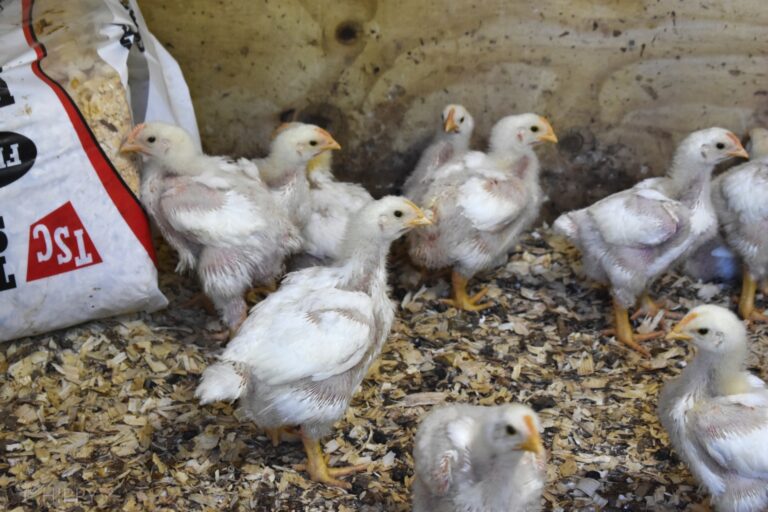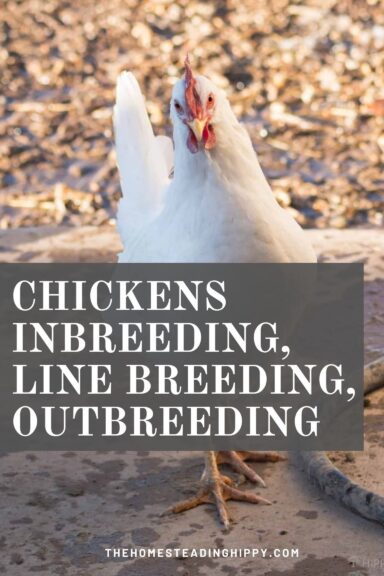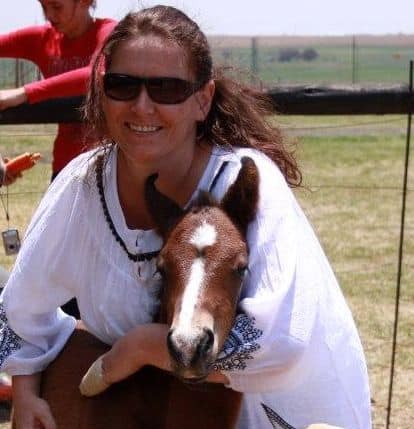If you want to increase your flock size without having genetic challenges that have a negative impact on egg production, meat production, and physical appearance, you will need to know a bit about how to breed your chickens safely.

You have three choices, inbreeding, line breeding, or outbreeding. Each has its own pros and cons, and each has its own limits. As homesteaders, we really only breed our birds for two reasons:
- Egg production
- Meat production
There are three ways to naturally breed chickens. I say naturally because of the large-scale cloning or genetic engineering being done by industry. As a homesteader, you can choose between:
- Inbreeding
- Linebreeding
- Outcrossing (outbreeding)
Inbreeding is the pairing of direct relatives, i.e. father + mother followed by father to daughter, son to mother. This breeding pattern is not typically closely monitored or controlled. Generations are left to pair with their close relatives.
This is the least desirable way to breed as the lack of new DNA will eventually lead to physical, characteristic, and production limitations, i.e. lower production of eggs, smaller sized eggs, and lower meat yield.
Line breeding is also a relational pairing, but it is controlled by the pairing of distant relatives, i.e. rooster to niece, niece to nephew. It involves a lot more monitoring of generations and controlled breeding.
Outbreeding is the introduction of a new, unrelated rooster to the existing hens with every generation. This is the best way to breed as the persistent new DNA means fewer defects in the chicks.
In this article, I am going to guide you through each method and the pros and cons of the different methods…
Choosing the Best Chickens to Breed With
When we look at chickens as homesteaders, we’re often tempted to leave our birds to breed as they please; however, in the long run, leaving them to do the “what comes naturally…” can lead to issues such as inbreeding for too many generations will lead to infertility and deformity.
That being said, there are several things we can do to ensure the maintenance of a healthy flock…
You need to choose the healthiest chickens in your flock to breed with. Look at appearance, production, and good temperament for healthy growth.
Chickens breed with more intensity during spring. This is the time when you should pair up your breeding pairs in seclusion from undesirable flock members.
Understanding the Role of Chicken Genetics to Successful Breeding
Just as with people, chickens all have unique DNA. Also, just like people, it’s essential to refresh it by breeding with new DNA.
When people mate with relatives over generations, physical, health, and emotional defects will occur.
The same is true for chickens, the more they mate with relatives, the more defects will occur. They may become more aggressive, and depressed, and they will produce fewer and low-quality eggs, they will have physical defects, and have fewer hatched births.
For this reason, it is recommended that you introduce new chickens to your flock regularly. It is considered safe to breed within families for up to six generations before defects begin to show.
Industrial chicken farmers will often try to keep desirable traits through cloning or gene editing. But this is only really relevant to actual breeders…
I was a breeder for many years a lifetime ago with runs of 1500 birds per run x 12 runs, and even then, I found that just introducing new birds to pair for breeding purposes created healthy, stronger, more diverse flocks.
The sixth generation should be retired from your breeding program.
Basic Terminology
Before I go any further, there are a few terms that need to be understood. So here are the boiled-down terms for you to understand them when they are brought up in the article.
Homozygosity
Homozygosity results when birds are primarily inbred. Pervasive inbreeding can result in recessive traits.
It leads to a decrease in biological fitness that reduces the reproductive effectiveness and results in high morbidity and mortality. This is referred to as inbreeding depression.
Homozygosity will cause:
- severe hearing loss,
- deformed bodies,
- inability to reproduce or produce healthy chicks,
- malformed facial features,
- and progressive illness resulting in death.
Prepotency
Prepotency refers to the selective, favorable physical characteristics of the parents such as the size of breasts, weight, and general appearance being passed down to chicks. It doesn’t refer to the specific breed or the sex of offspring.
Prepotency does include cross breeding to create a new breed that has more favorable characteristics. This does take many generations to develop and is therefore done by serious breeders with sound scientific knowledge.
Deleterious Recessive Mutation
Deleterious genetic mutations are more likely to occur in homozygous flocks. These genetic mutations can cause a decline in fertility, stunted growth, deformities such as:
- leg deformities or missing eyes (among others),
- decline in reproduction,
- a low birth rate with a high mortality rate,
- decline in egg production,
- neurological disorders,
- a short lifespan,
- a compromised immune system,
- and albinism.
In other words, the more you limit the introduction of new DNA, the higher the chances are that you place a risk of negative mutations and the higher the risk is to the health and reproduction of the flock. This is especially evident in inbreeding, but also to an extent in line breeding.
Positive Deleterious Mutations / Heterosis / Hybrid Vigor
These mutations happen when specific pairing is practiced in order to reduce or eliminate negative or unwanted characteristics.
Positive deleterious mutations, Heterosis (hybrid vigor) occurs when crossbreeding to enhance specific genetic qualities such as egg production, egg size, or higher meat yield takes place.
This breeding can result in bigger or meatier birds, higher egg production, higher reproduction rates, and healthier chickens.
As a homesteader, you may have different breeds pairing up, but without careful control and consistency, crossbreeding will be inconsistent and unpredictable.
Inbreeding
Inbreeding is where close relatives pair to breed. As homesteaders, this is the way many of us breed because it doesn’t require too much effort or intervention.
So inbreeding involves breeding within families. In other words, father and daughter, brother and sister, cousins, and son and mother, etc.
Preferably you should avoid brother and sister pairing, as sibling pairing can rapidly result in genetic defects because of the close generational DNA match.
This is only a safe method up to the sixth generation. The closer you get to that sixth generation the more likely you are to see deformed chickens, death in eggs, low weight, and reduced egg yield.
The answer to these issues is either to monitor each generation to limit the number of generations or introduce new chickens to your flock every year.
I recommend that you introduce new chickens to the flock every year. You don’t need to fully replace your flock. You will have a death or two every year – from illness or from your meat needs – and so you will basically be replacing these chickens.
I suggest a new rooster and two or three new hens from a new bloodline.
Pros of Inbreeding
Inbreeding does have some benefits if done correctly by introducing other chickens periodically that were not hatched onsite.
These include:
- Uniform generational strains,
- Easy to control by separating breeding pairs,
- Can be used to ensure that good characteristics are passed down.
Cons of Inbreeding
The most serious cons attached to inbreeding are:
- Inbreeding depression,
- Decline in fertility,
- Decline in reproduction,
- Low birth rate,
- High mortality,
- Deformed chicks,
- Bad temperament,
- Stunted growth,
- Decline in egg production,
- Compromised immune systems,
- Lower meat yield,
- Shorter lifespan,
- Neurological disorders,
- Blindness,
- Missing eyes,
- Leg deformities,
- Twisted beaks,
- Smaller eggs,
- Albinism,
- Homozygosity – recessive traits or genetic disorders,
- Requires a lot of knowledge and input to monitor and pair through generations.
Linebreeding
Linebreeding can be easier to manage than inbreeding and has real benefits in terms of genetic rejuvenation. It is not as ideal as outbreeding, but it is safer than inbreeding as direct relatives are not exclusively bred with your existing flock.
Where inbreeding is the breeding of a close family, i.e. father to daughter, son to mother, line breeding is the breeding of a more distant family member, e.g. aunt to father, nephew to niece.
It’s similar to inbreeding in as such that you’re still breeding within the same gene pool, but rotating the generations does reduce the effects of exhausted DNA.
Because the gene pool is widened through mating distant relatives the risk of deformities and illnesses in flocks is reduced. It doesn’t completely do away with all the issues found in inbreeding. Ancestors do still carry similar DNA.
Pros of Line Breeding
There are pros that outweigh those of inbreeding. These include:
- High-quality offspring,
- The desirable traits are maintained,
- When done correctly, genetically undesirable traits can be done away with,
- Consistent temperaments,
- Consistent physical characteristics,
- Homozygosity is greatly reduced,
- Prepotency is more consistent,
- Genetic resources are conserved.
Cons of Line Breeding
Line breeding also has some hangups though. When it comes to backyard chickens, nothing is really guaranteed. There will still be cons that are similar to cons found in inbreeding – you are still breeding within familial DNA. The risks are less prevalent, and you’ll be able breed more generations than the 6 ‘safe’ generations in inbreeding.
Here are some of the cons of line breeding:
- Limits genetic diversity,
- This can lead to a major deleterious recessive mutation in their DNA,
- This can lead to homozygous issues,
- Undesirable traits can be carried on to chicks,
- Shorter life expectancy,
- Heightened risk of inherited diseases,
- Low egg production.
Outbreeding and Outcrossing
Outbreeding is often, mistakenly, referred to as outcrossing, however, there’s a difference between the two…
Outcrossing
Outcrossing refers to the pairing of two breeds to get specific, desirable offspring.
An example of outcrossing could involve a pairing of a Sussex chicken with an Orpington to achieve a meatier bird or a more docile bird. The resulting bird would eventually be a new breed altogether.
This is done by scientific intervention by specialist breeders. This isn’t typically done by average people who just keep chickens for egg and meat production for the use of being self-sufficient.
Outbreeding
Outbreeding, on the other hand, is when you pair two birds that are not related but are the same breed.
If you have 4 hens and 1 rooster (this is the right ratio of hens per rooster), the result would be 14 eggs being hatched at a time by each hen. To get the healthiest chicks, you should remove all the roosters as soon as possible after the chicks hatch, and replace each rooster with an unrelated rooster.
That is outbreeding…
You cannot use direct relatives as done in inbreeding or linebreeding.
To outbreed, you cannot use new chicks to pair with any relatives. You have to introduce new blood into your flock each breeding season. It is easier to switch out roosters than hens because you need more hens than roosters to breed.
Outbreeding requires a lot of attention, effort, and paperwork to ensure that relatives do not breed, but the effort spent is very beneficial.
Pros of Outbreeding
Given that outbreeding is the best way to breed chickens successfully, the benefits are very notable:
- Outbreeding ensures fresh DNA,
- Introduces elite alleles – this is the same as heterosis (hybrid vigor) – desirable traits,
- This leads to the direct benefits of inbreeding and linebreeding without the messy cons,
- Easy to pair nonrelated pairs,
- The chicks are of higher quality,
- Fewer deaths,
- Fewer deformities,
- Consistent prepotency,
- Easy to breed by just adding a new rooster with each batch of chicks as well as with the previous generations of hens.
Cons of Outbreeding
There are always some issues when breeding any livestock. Just because outbreeding is the safest way to maintain good DNA, it’s not impervious. The cons are fairly easy to fix, here are the main ones:
- Attention and effort are required to ensure that different family genes are passed on,
- Requires regular introduction of new bloodlines,
- This can lead to unexpected behavioral and physical characteristics,
- Can make character traits unpredictable,
- Time must be spent on health screening,
- Detailed records must be maintained, this can be time-consuming.
Encouraging Healthy Mating
As I have said before, homesteaders – many that I know – tend to keep their flock together and just let them breed as they want. It’s apparently easy and doesn’t take much effort. This is inbreeding and will eventually result in disaster.
Breed selectively with different birds. It is more cost-effective to replace your rooster regularly.
Breed with healthy birds. Never breed birds that have ongoing health issues.
Breed with birds that have good temperaments. Choose to breed birds with good traits like high egg production or high meat yield.
Concentrate on breeding in spring. This is when chickens tend to breed; it is therefore the best time to focus on putting good, fresh roosters with your selected hens. Breeding will happen over 3 months. In the northern United States of America, this will be from January to March.
The ratio for breeding is 1 rooster to 4 to 5 hens. Any less and your hens will be begging for Tylenol.
During breeding season (spring) make sure you keep your rooster with your hens. This affords a good time to fertilize eggs that are laid over a period of days; remember hens lay one egg a day until they have a good, fertilized clutch of eggs. This takes 2 to 3 weeks.
Make sure your rooster is a healthy weight. If he’s overweight, he may be too lethargic to mate.
Selective breeding is vitally important if you want ongoing healthy chickens. Your gene pool must be diverse to ensure chicks come out healthy with each breeding season.
Inbreeding FAQ
Q: How do I know when inbreeding has gone too far?
A: If you notice any indicators such as reduced egg production, lifespan, or deformities, you should not inbreed. These are clear indicators that generational inbreeding has gone too far.
Q: What is better, line breeding, inbreeding, or outbreeding?
A: Outbreeding ensures a wider genetic range; this results in healthier, more productive chickens.
Q: What makes line breeding better than inbreeding?
A: Line breeding affords better control over breeding and therefore lowers homozygosity and increases prepotency. This means healthier chicks with lower death rates and fewer malformations.
I hope you’ve learned from this article and are better equipped to make better mating decisions and breeding practices. If you have any questions or tips you use to breed healthier chickens over generations, drop a note in the comments below.


Di-Anne Devenish Seebregts was raised in an environment where daily life consisted of hiking, environmental conservation, growing fruit and vegetables, and raising poultry for meat and eggs.
She combined her passion for the writing word with her love of the pride that comes with not relying on others. She raised three children (who are now adults) to value the environment, and understand the value of being self-sufficient.
Find out more about Di-Anne on our About Us page.
